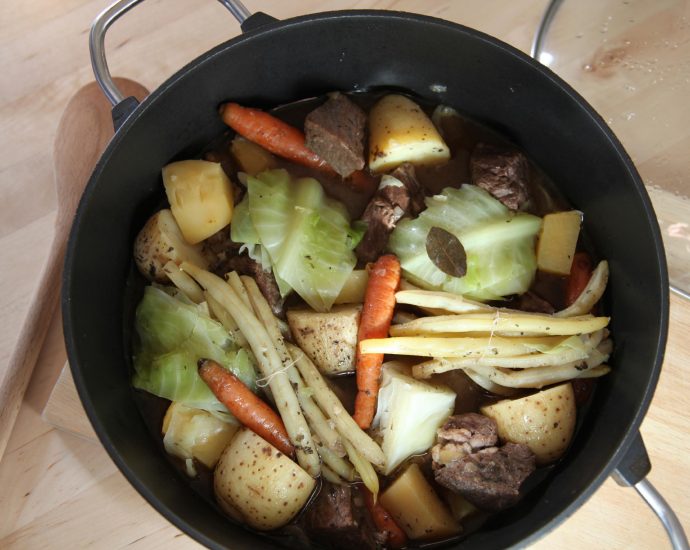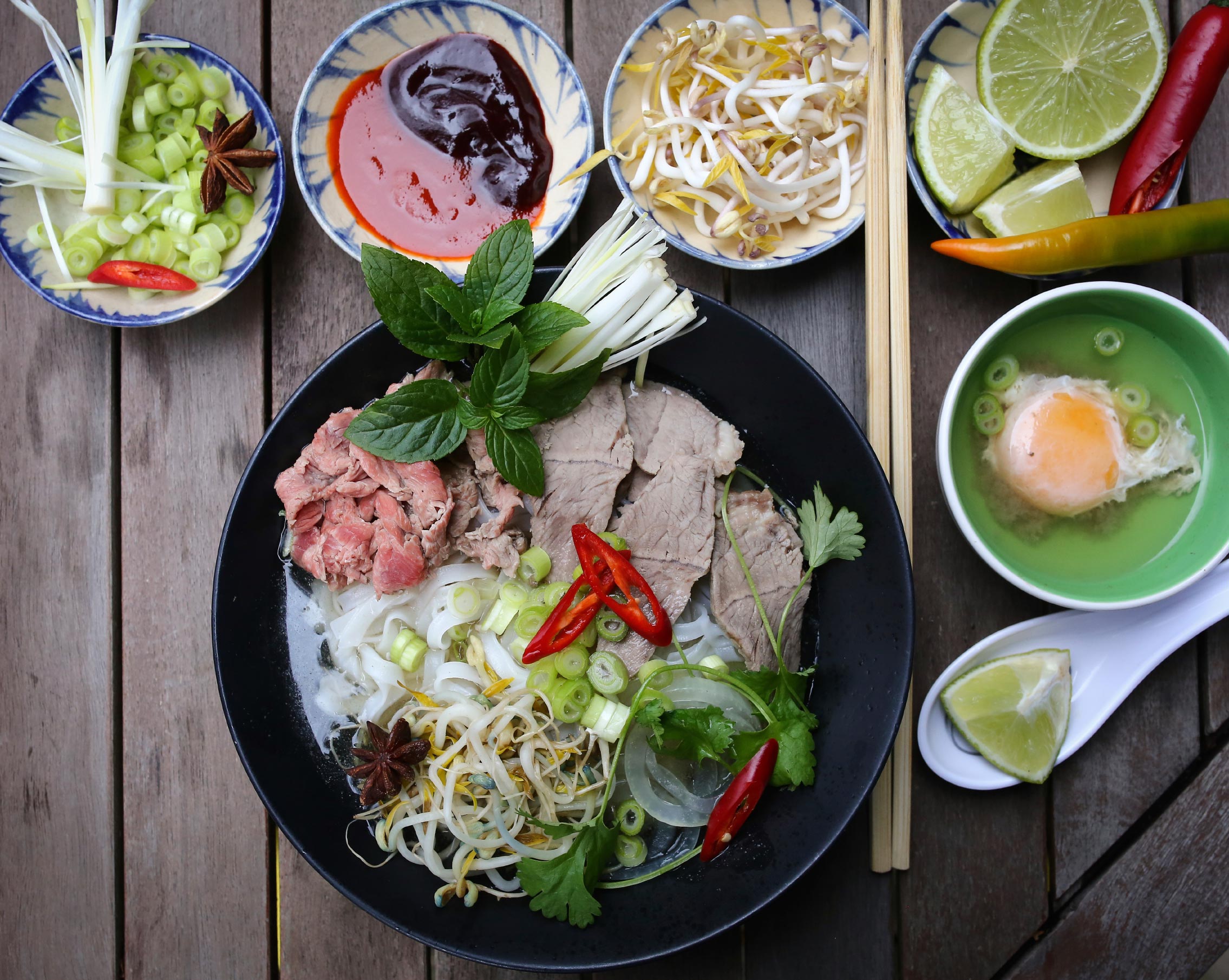It is with beef that the excellent pot-au-feu is made, a very French dish which, in spite of its simplicity, provides a complete meal for the soldier and the working classes. It is also a favorite with the rich. In France, pot-au-feu is the symbol of family life.
Ma Cuisine August Escoffier
Pot-au-feu and pho are two dishes that share the same central ingredient, beef, and the same cooking method, a gentle and lengthy simmering of meat and aromatics. The quality of both preparations is vastly enhanced by the cook’s attention to detail–the careful maintenance of temperature, the vigilant skimming of the broth, the use of flavorful cuts of meat, the freshest herbs and vegetables. Both dishes are more successful when made in quantity and provide a complete meal in a bowl. There are innumerable variations, depending on the region of the country and the cook’s individual style. They share a historical connection, through France’s colonization of Vietnam, as well as a symbolic connection, with their ability to evoke memories of lively family meals and preserved traditions. At the same time, pot-au-feu and pho differ vastly in taste and texture, even the time of day they are usually enjoyed. Each reflects the deep savour of its own culture.
Pot au Feu
A great pot-au-feu begins with a variety of cuts of beef, often including shank bones, chuck roast, and short ribs. A bouquet garni, a sprinkling of salt and an onion piqué, are added. The meat and aromatics are covered with cold water or beef stock, the pot is brought to a boil, and the heat is then reduced to the barest simmer. The meats cook for several hours until tender, while the cook carefully skims impurities and fat. Forty-five minutes or so before the end of cooking, a selection of vegetables, including carrot, turnip and leek, are added to yield a broth which should be richly flavored without tasting of fat. The clear soup, corrected for seasonings, can be served as a first course with toasted bread. This course is followed by the poached meats and vegetables, with a selection of condiments to act as a contrast and compliment to their richness. Served on the side, there is usually a strong mustard, coarse salt, cornichon, and perhaps a tomato sauce, piquante sauce, or horseradish. This is a classic dish for a Sunday afternoon, shared with family and friends and washed down with copious quantities of conversation and red wine.
Here is Anthony Bourdain’s detailed recipe for Pot au Feu.
Our soup would arrive. We would bend down and inhale the aromas….Invariably the broth smelled utterly beefy, laced with just-roasted spices…A taste of home, it warmed our spirit and gave us the comfort and solace needed during our first difficult years in America.
Pleasures of the Vietnamese Table Mai Pham
Pho
Pot au feu’s place in the French repertoire also led to the development of the Vietnamese soup, pho. The French invaded Vietnam in 1857. By June 1861, the Vietnamese, unable to resist the invaders with their modern weaponry, were under French rule. Expatriate households were established as a period of economic exploitation began. The French must have been pleased with their new servants, for the Vietnamese cooks had their own well-established tradition of reverence for food, an array of refined cooking techniques and a profound understanding of the importance of presentation. Up to this time in Vietnam, cattle and buffalo were used only as beasts of burden. Rice was the staff of life, and pork, seafood, and chicken were the main sources of protein.
During the colonial period, after exposure to the French dining preferences, upper class Vietnamese began to emulate the tastes of their occupiers by preparing and enjoying red meat. At the same time, Vietnamese servants learned to prepare the pot-au-feu for their new masters, assuaging the nostalgia of a group of people far from home. While pho has it’s roots in the French colonial period, the Vietnamese were quick to add their own preferences and style to this important dish. While the soup can appear anytime during the day, it was especially savored for breakfast. Pot au feu, traditionally important in the French repetoire, was translated into Vietnamese with the use of indigenous ingredients and even became a part of a Vietnamese nationalist campaign. In the 1930s eating pho was promoted as a patriotic act.
As with pot au feu, pho begins with the long careful simmering of tough flavorful cuts of beef and bones that are rich in marrow. The finest broths are judged by their clarity, so the careful cook soaks the bones in cold water overnight to loosen impurities and then blanches them the next day, rinsing the pot and the bones before the final preparation begins. Fresh ginger and an onion are charred, serving a similar function as the onion brulée in French food but with a different flavor note due to the addition of ginger. Shallots, star anise, lemon grass, and cinnamon stick, aromatics that appear in many different combinations in local dishes, are added to the broth. Fat and scum are carefully removed throughout the cooking process, which continues until the beef is meltingly tender. This rich and marvelously spicy broth is strained, the meat reserved, and the soup is finally flavored with the all-important nuoc mam rather than salt.
In addition to the beef, the other defining component of the soup is rice noodles. Just before service, rice noodles are blanched, one portion at a time, until soft but still chewy and placed at the bottom of large preheated bowls along with the reserved meat. The boiling broth is ladled on top, often accompanied by paper-thin slices of onion and raw sirloin, which cook instantly in the hot soup. Part of the magic of pho and what gives it a distinctly Vietnamese character are the accompaniments. It is served with a platter of pristinely fresh bean sprouts, slivered hot chilies, lime wedges, and an array of aromatic herbs including Asian basil, mint, cilantro, and culantro. This is a part of the marvelous tradition of paring rich long-simmered ingredients with crisp raw ingredients, which then act as a compliment and foil. Each diner participates in the final preparation by seasoning his own bowl to his individual taste with these elements.
Here is Andrea Nguyen’s detailed recipe for Pho.



What a delight. This is endless. This journal will keep me company all winter long!!
(I don’t even know whether my comments are posted in the appropriate places…pages…but it doesn’t matter.)
Thank you Lisa for the inspiration for a winter soup meal. Being a vegetarian, I modified the Pho using the following recipe.
Vegetarian Phở (Vietnamese Noodle Soup) Modified
http://www.thekitchn.com/recipe-vegetarian-pho-107312
http://www.vietworldkitchen.com/blog/2008/10/pho-beef-noodle-soup.html
Notes: Instead of commercial vegetable stock, I followed Mark Bittman’s advice and simply took available vegetables to be used in the recipe and made a quick 10 minute vegetable stock. Much healthier and tastier! http://cooking.nytimes.com/recipes/1017137-mushroom-stock
To replace the comfort of the missing beef, the spices listed may be amplified according to taste to produce a satisfying savory flavor.
Serves 2
Broth
1 large onion, peeled and halved
2-inch piece fresh ginger root, peeled and halved lengthwise
3-inch cinnamon stick, preferably Vietnamese cassia-cinnamon
1 star anise
2 cloves
1 teaspoon coriander seeds
4 cups unsalted vegetable stock.
2 teaspoons soy sauce
4 carrots, peeled and coarsely chopped
Noodles
1/2 pound dried flat rice noodles (known as bánh phở; use 1/16″, 1/8″, or 1/4″ width depending on availability and preference)
Toppings (optional)
Protein such as fried or baked tofu, bean curd skin, or seitan
Mushrooms
Vegetables such as bok choy, napa cabbage, or broccoli
Garnishes
1/2 onion, very thinly sliced
2 scallions, thinly sliced
1 chile pepper (Thai bird, serrano, or jalapeño), sliced
1 lime, cut into wedges
1/2 cup bean sprouts
Large handful of herbs: cilantro, Thai basil, culantro/saw-leaf herb
Hoisin sauce, sriracha (optional)
For the broth
Char onion and ginger over an open flame (holding with tongs) or directly under a broiler until slightly blackened, about 5 minutes on each side. Rinse with water.
In a large pot, dry roast cinnamon, star anise, cloves, and coriander over medium-low heat, stirring to prevent burning. When spices are aromatic, add vegetable stock, soy sauce, carrots, and charred onion and ginger.
Bring broth to a boil, reduce heat, and simmer, covered, for 30 minutes. Strain and keep hot until ready to serve.
For the noodles
While broth is simmering, place noodles in a large bowl and cover with hot water. Let stand for 20-30 minutes or until tender but still chewy. Drain. (If soaking does not soften the noodles enough, blanch them in a pot of boiling water for a few seconds.)
For the toppings (optional)
While broth is simmering, prepare toppings as desired – slice and cook tofu, lightly steam or blanch vegetables, etc. Toppings should be unseasoned or only lightly seasoned so as not to interfere with the flavor of the broth.
To serve
Divide noodles between two bowls. Arrange toppings over noodles. Ladle about 2 cups of broth into each bowl. Serve with garnishes on the side, which diners should add to taste.
Roy,
Thanks so much for sharing this information and recipe. I know a number of readers are vegetarian and will really appreciate being able to enjoy the pho flavor but in a format they can eat. I am starting to work on the spring issue of the Gazette and one of the major topics will be flavor and taste. I have been reading about the power of umami to add a “meaty” taste. Dried shiitake mushrooms and kombu seaweed, very rich in compounds that are associated with umami, would also be great in the broth to amplify the savoriness of vegetarian pho.